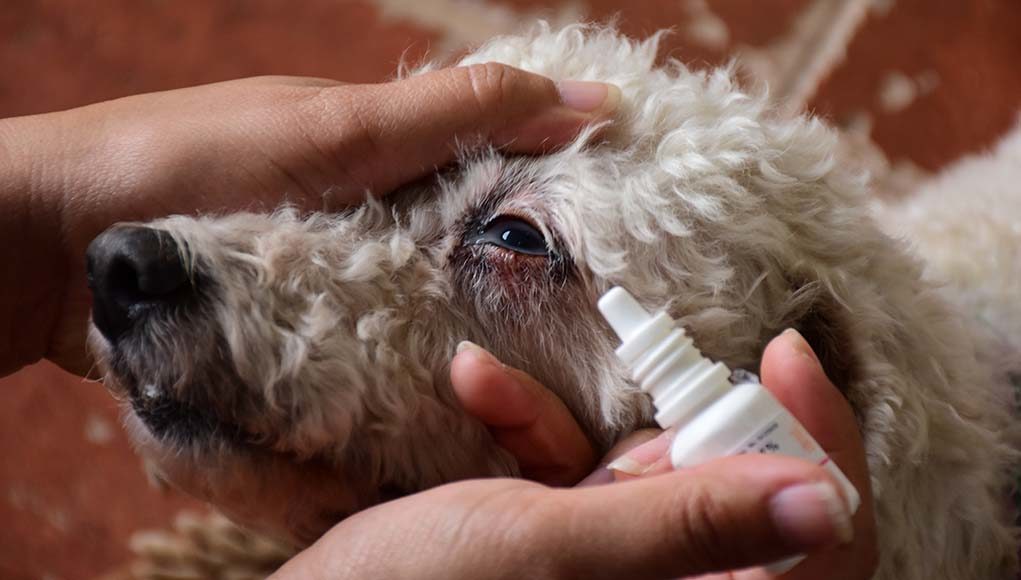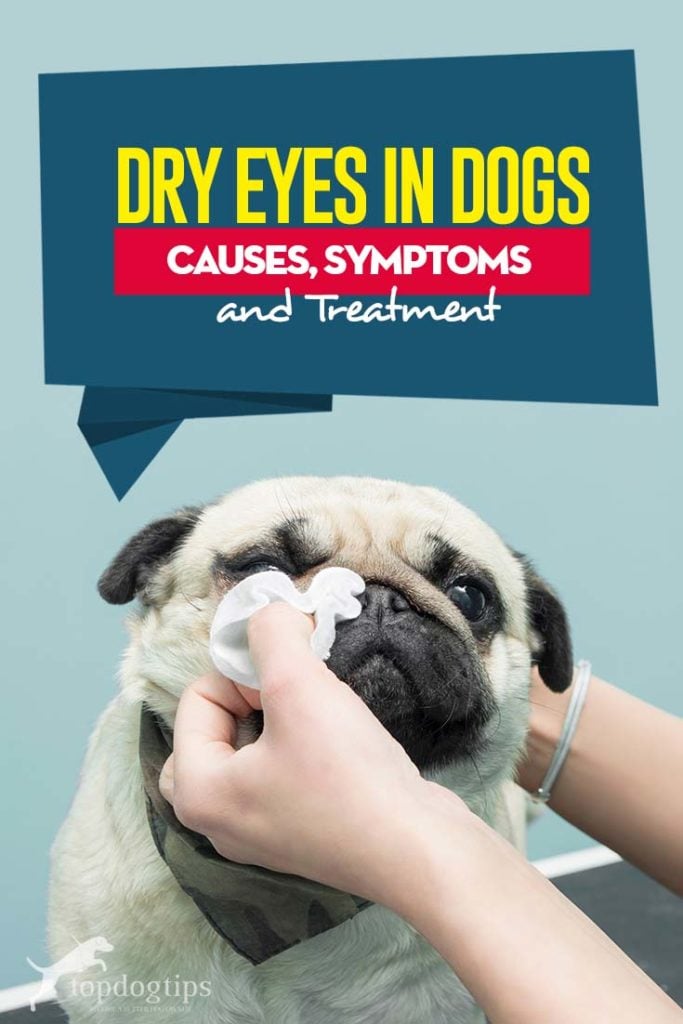Table of Contents
Dry eyes in dogs, known as Keratoconjunctivitis sicca (KCS), is a highly common canine eye disease. In North America, reported annual rates of this syndrome are from 0.3% to 1.52% (1, 2). It usually affects dogs, but it is not rare in cats either, especially after infection with the feline herpesvirus infection.
In most cases, this highly painful syndrome affects both of the dog's eyes, even though it may seem that one eye is in a more severe condition than the other. Although it can occur at any age, the highest incidence in dogs is at the age of 4 to 6 years (3). Female dogs are also more prone to this than male dogs (4).
Causes of Dry Eyes in Dogs
With the exception of dogs born without tear glands, the most frequent causes of dry eyes in dogs are the following.
Misdirected reaction of the immune system. The most common reason for the occurrence of dry eye in dogs is an inadequate reaction of their immune system against the tear glands and their destruction over time (5, 6). It is estimated that an immune problem causes dry eye in approximately 80% of dogs (7).
Congenital ocular defect. Some dogs are born with this disorder, which inhibits the production of tears and leads to eye dryness (8, 9). Even though it is quite rare, the ocular defect is considered one of the primary forms of dry eye. Unfortunately, there is no adequate conventional treatment available for this condition.
Infective. An infection of the central nervous system, which causes the interruption of the nerves of the tear glands or traumatic proptosis, may become a reason for the appearance of this disease. Also, the dry eye often appears after infection with canine distemper virus and leishmania (10, 11).
Chronic diseases. Systemic viral infections, chronic blepharoconjunctivitis, chlamydia conjunctivitis, immune-mediated adenitis, and Cushing's disease can cause the occurrence of this syndrome.
Drug-induced. It may occur as a result of toxic drug effects on a dog's tear glands. Atropine, general anesthesia, and sulfa-containing drugs usually cause transient dry eye syndrome in pets. This could be either temporary or permanent (12, 13, 14).
Radiation. Direct contact with X-rays may cause the appearance of dry eyes, especially in predisposed breeds because it negatively affects the dog's lacrimal glands. Fortunately, this is very rare (15).
Metabolic. One of the reported complications of hypothyroidism and diabetes mellitus in dogs is keratoconjunctivitis sicca (16, 17).
Iatrogenic. Since 30% of the dog's tear production depends on the third eyelid, its removal (such as in the case of cherry eye), especially in predisposed breeds, will cause the occurrence of dry eye. The KCS symptoms will often develop much later in a dog's lifetime (18, 19, 20)
Idiopathic. In many cases, dogs can suffer from a spontaneous form of dry eye without the possibility of determining an underlying etiology (21). Middle-aged female dogs were also reported to have a dry nose at this stage.
Breeds Prone to Dry Eye
Dry eye is a syndrome that can appear in any dog, but some pedigree breeds suffer from this condition more often. For example, the results of relevant studies show that the prevalence of this condition in Shih Tzus in the US is approximately 1% (22).
Flat-faced brachycephalic dogs are more prone to the development of keratoconjunctivitis sicca as well, with female West Highland White Terriers being most at risk (23, 24).
Other dog breeds known to develop dry eyes are (25): Cavalier King Charles Spaniels, English Bulldogs, Lhasa Apsos, Shih Tzus, Pugs, Bloodhounds, American Cocker Spaniels, English Cocker Spaniels and English Springer Spaniels, Pekingeses, Boston Terriers, Miniature Schnauzers, and Samoyeds.
Symptoms and Clinical Signs
If a dog belongs to one of the breeds that are prone to keratoconjunctivitis sicca, it is necessary to react right away after noticing yellowish mucus in the dog's eyes, eye boogers, redness in the surrounding area, and/or excessive blinking.
Besides these first symptoms, there are many additional signs of this condition, such as:
- Cloudy eyes without the usual shining
- Rubbing the eyes and the entire face
- Sticky eyes with dried brown mucus or pus around the affected area
- The swollen surface of the eyes and conjunctival blood vessels
- The prominent third eyelids
- The occurrence of hyperpigmentation and eye ulcers
- Loss of vision
There are three prominent stages of dry eyes in dogs (see photos below; © Dodi PL). The initial stage will have some eye discharge, conjunctival hyperemia and blepharospasm. The second/intermediate stage will have a more intense mucus discharge, corneal opacification, and corneal vascularization. The last and final stage will show signs of fibrosis, eye pigmentation, and recurrent ulceration (with possible blindness).
First stage: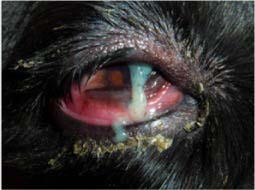
Second stage: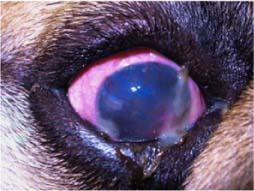
Third (final) stage: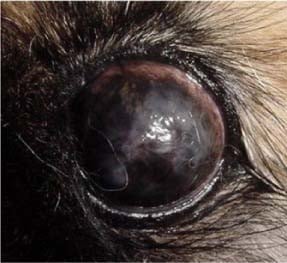
Diagnosis of Dog Dry Eyes
Like with other eye infections, in the majority of cases, the medical history of the dog and visual inspection of the dog's eyes are enough for diagnosis. However, there is a simple Schirmer tear test as the gold standard for the determination of the level of decreasing production of tears in dogs (26).
There are two types of this test available:
STT I – By using the STT I, the veterinarian will measure both components of the tear film, the basal, and reflex, without applying a local anesthetic.
STT II – After the application of topical anesthetic, the vet can use STT II to measure just the basal component of the tear film.
The procedure is not complicated. By using a special wicking paper, the vet will determine the amount of tears the dog's eyes produce in the tear ducts.
After placing the paper behind the lower lid, the blue wetted trace will show the level of tear production per minute. In healthy dogs, the test paper will be wet approximately 0.6 to 1 inch (15 – 25 mm).
When the dog has a problem with dry eyes, the Schirmer tear test will be reduced, and the result will be lower than 0.4 inches (10 mm). In most severe cases, there will be no wetting at all.
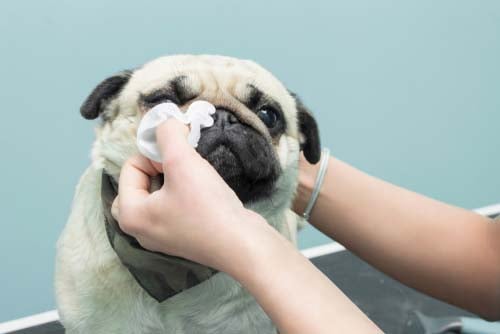
Treatment of Canine Dry Eye
The treatment for this syndrome primarily depends on the primary cause. After eliminating existing secondary infections, the vet will begin with therapy that can be either medical or surgical. Luckily, most dogs respond to medical ones.
Antibiotic drops. They are an excellent solution to solve secondary infections, which you can apply at home. It is crucial since applying immunosuppressants can be highly dangerous while an active infection is present. These eye drops will need to be prescribed by a vet.
Cyclosporine. There are two ways this immunosuppressant works. Its work will be hormonal-related during the first days. After that, the immune-related effect occurs, which will last up to three months. Therefore, therapy must continue for at least 60 to 90 days. In some cases, the dog won't react to this therapy, and the vet can prescribe tacrolimus or pimecrolimus as an excellent replacement.
Artificial tears. These tear substitutes will stimulate the remaining lacrimal tissue to produce tears in a dog. There are three categories of these preparations, including polyvinyl alcohols, linear polymers, and cellulose derivatives. It's up to your veterinarian to determine which option is the best for your specific pet.
Surgery. This is the last resort after the above veterinary treatments do not work to fix the issue. This option is necessary to decrease corneal exposure in cases when a dog's tear glands are obstructed or damaged. Parotid duct transposition surgery is most suitable in the majority of cases (27).
The good news is that all treatments available are highly effective for fixing dry eyes in dogs. The bad news is that these medications help in the control of the problem but can't completely cure it. Basically, once the dry eye develops in your pooch, the therapy will be lifelong management, but it's not complicated.
Supplements for Dog's Eye Health
Taking supplements, including vitamins A, E, C, and B complex, are beneficial for dogs suffering from dry eye syndrome as well as to potentially prevent this condition.
Also, when dry eyes have already developed, eye washing with Euphrasia (Eyebright) may help. Some anecdotal evidence suggests that feeding a dog with raw or cooked beef and chicken liver helps the condition due to their vitamin complex.
Some of the best supplements for dog eyes are:
| Preview | Product | Rating | |
|---|---|---|---|

|
Ocu-GLO Vision Supplement for Medium to Large Dogs... | 2,661 Reviews | Check Price |

|
Pet Wellbeing Nettle-Eyebright Gold for Dogs -... | 169 Reviews | Check Price |

|
Zesty Paws Eye Supplement for Dogs - Vision... | 2,063 Reviews | Check Price |
Prevention
Keratoconjunctivitis sicca is one of the rare conditions that cannot be completely prevented. Care for a dog's eyes, a healthy diet, and supplementation to ensure proper delivery of vitamins and minerals may prevent it, but there's no evidence of that.
The key to successful treatment of dry eyes in dogs is early detection of the first symptoms followed by a timely reaction. Before getting a pedigree dog, take care of their potential health problems, including this syndrome.
Cost
Treatment of this particular eye condition in dogs can be highly expensive since it requires lifelong management. Therefore, looking into pet insurance as soon as you've adopted a dog is a wise decision. Once the syndrome occurs, you will not be able to insure the dog with most, if not all, providers. In that case, the only option is a consultation with a vet about treatment options and the lifelong costs.
READ NEXT: Dog Won’t Open His Eyes? Here’s What This Means
Disclosure: We may earn affiliate commissions at no cost to you from the links on this page. This did not affect our assessment of products. Read more here and find full disclosure here.
Want to share this?


